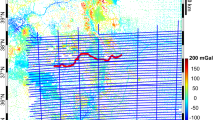Abstract
The geoid computation method currently used at the US National Geodetic Survey is based on the analytical downward continuation solution of the Molodensky geodetic boundary value problem. The quasigeoid is computed first in 1′ × 1′ grids for the whole area, and then, the geoid is obtained by adding the geoid–quasigeoid separation term based on the simple Bouguer anomalies. A few variations in data combination and topographic/gravity reductions are tested, and three models are selected for the Colorado experiment. Historical GPS/leveling data are used as a guide in the computations. The standard deviation of geoid differences between the historical GPS/leveling data and geoid models is 5.2, 5.0 and 4.9 cm for the models of the initial run, the first and second iteration, respectively. After the models were submitted to the Colorado experiment, they were validated using the GSVS17 (Geoid Slope Validation Survey 2017) GPS/leveling data. The standard deviation of the geoid differences on 223 GSVS17 marks is 3.2, 2.6 and 2.3 cm for the three runs, respectively. In addition to the (quasi)geoid models, the geopotential numbers at 223 GSVS17 marks are also computed and submitted to the Colorado geoid computation experiment and it is evaluated in Sánchez et al. (2020 this issue).





Similar content being viewed by others
Data availability statement
The data that support the findings of this study are available from the corresponding author upon reasonable request.
References
Ågren J (2004) Regional geoid determination methods for the era of satellite gravimetry. PhD dissertation, Royal Institute of Technology
Flury J, Rummel R (2009) On the geoid–quasigeoid separation in mountain areas. J Geod 83:829
Forsberg R (1984) A Study Terrain Reductions, Density Anomalies and Geophysical Inversion Methods in Gravity Field Modelling. Report No. 355, Department of Geodesic Science and Survey, Ohio State University, Columbus, OH
Forsberg R, Tscherning, CC (2008) An overview manual for the GRAVSOFT, Geodetic Gravity Field Modelling Programs, 2nd edition
Heiskanen W, Moritz H (1967) Physical Geodesy. W.H. Freeman and Company, San Francisco
Jiang T (2016) Wang, YM (2016) On the spectral combination of satellite gravity model, terrestrial and airborne gravity data for local gravimetric geoid computation. J Geod 90:1405–1418. https://doi.org/10.1007/s00190-016-0932-7
Moritz H (1980) Advanced Physical Geodesy. Herbert Wichmann Verlag, Karlsruhe
Roman DR, Wang YM, Henning W, Hamilton J (2004) Assessment of the New National Geoid Height Model, GEOID03, Proceedings of the American Congress on Surveying and Mapping 2004 meeting
Sánchez et al. (2020, this issue) Strategy for the realization of the International Height Reference System—IHRS
Sánchez L, Ågren J, Huang J, Wang YM, Forsberg R (2018) Basic agreements for the computation of station potential values as IHRS coordinates, geoid undulations and height anomalies within the Colorado 1-cm geoid experiment. Version 0.5, October 30, 2018
Sjöberg LE (2007) The topographic bias by analytical continuation in physical geodesy. J Geod 81:345–350
Sjöberg LE (2010) A strict formula for geoid-to-quasigeoid separation. J Geod 84:699
Smith DA, Milbert DG (1999) The GEOID96 high resolution geoid height model for the United States. J Geod. 73:219–236
Smith DA, Roman DR (2001) GEOID99 and G99SSS: one arc-minute models for the United States. J. Geod. 75:469–490
Smith DA, Roman DR (2010) How NOAA’s GRAV-D Project Impacts and Contributes to NOAA Science, https://www.ngs.noaa.gov/GRAV-D/pubs/GRAV-D_Contribution_to_NOAA_Science.pdf, May 7, 2010
Smith DA, Holmes SA, Li X, Guillaume S, Wang YM, Bürki B, Roman DR, Damiani T (2013) Confirming regional 1 cm differential geoid accuracy from airborne gravimetry: the Geoid Slope Validation Survey of 2011. J. Geod. 87:885–907
VanWestrum D et al. (2020, this issue) Geoid Slope Validation Survey in the Rugged Terrain of Colorado, U.S.A
Wang et al. (2020, this issue) Colorado geoid computation experiment—Overview and Summary
Wang YM, Saleh J, Li X, Roman DR (2012) The US Gravimetric Geoid of 2009 (USGG2009): model development and evaluation. J Geod 86:165–180
Wang YM, Holmes S, Li X, and Ahlgren K (2017) NGS Annual Experimental Geoid Models – xGEOID17: What is new and the results, IAG-IASPEI, Kobe, Japan July 30—August 5, 2017
Wong L, Gore R (1969) Accuracy of geoid heights from modified Stokes kernels. Geophys J R astr Soc 18:81–91
Zilkoski DB (1992) North American Vertical Datum and International Great Lakes Datum: They Are Now One and the Same. In: Proceedings of the U.S. Hydrographic Conference ‘92, Baltimore, Maryland
Author information
Authors and Affiliations
Contributions
YMW, XL, KA and JK computed the models and prepared this paper.
Corresponding author
Rights and permissions
About this article
Cite this article
Wang, Y.M., Li, X., Ahlgren, K. et al. Colorado geoid modeling at the US National Geodetic Survey. J Geod 94, 106 (2020). https://doi.org/10.1007/s00190-020-01429-w
Received:
Accepted:
Published:
DOI: https://doi.org/10.1007/s00190-020-01429-w




